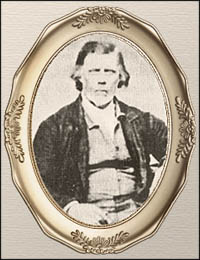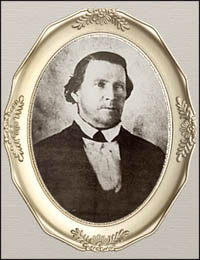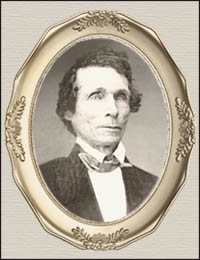
(view enlarged publication info.)
What were Joseph Smith, Jr. and his new "Spokesman" (Sidney Rigdon) doing
in Canandaigua, New York in December of 1830?


Why were the seventy converts to Mormonism, near the end of December, 1830,
spoken of as being distributed between Colesville and Canandaigua?

Vol. IV.
Nauvoo, Illinois, Sunday, October 1, 1843.
No. 22.

HISTORY OF JOSEPH SMITH.
(Continued.)
It may be well to observe here, that the Lord greatly encouraged and strengthened the faith of his little flock, which had embraced the fulness
of the everlasting gospel, as revealed to them in the Book of Mormon, by giving some more extended information upon the scriptures, a translation
of which had already commenced.
Much conjecture and conversation frequently occurred among the saints, concerning the books mentioned, and referred to in various places in
the Old and New Testaments, which were now no where to be found. The common remark was, they were lost books; but it seems the
apostalic churches had some of these writings, as Jude mentions or quotes the prophesy of Enoch, the seventh from Adam. To the joy of
the flock, which in all, from Colesville to Canandaigua, N. York, numbered about seventy members, did the Lord reveal
the following doings of olden times, from the prophesy of Enoch....
Note 1: At the end of 1830 there were three major concentrations of Mormon converts: A medium sized branch at
Colesville; a tiny "house church" centered around the Whitmers at Fayette and the Joseph Smith, Sr. family at nearby Kingdom; and an indefinite
number of Mormons living in Manchester-Farmington, in northern part of Ontario County (and a few more living in the adjacent townships of southern
Wayne County). The latter congregation would have included Martin Harris, Hyrum Smith, etc. Why were these known members left unmentioned,
while unidentified converts in the Canandaigua area were instead alluded to, as constituting one pole of the (then) tiny Mormon domain?
Note two: The only known baptized member(s) located at Canandaigua, specifically mentioned in Lucy Mack Smith's biography of her son, was
Thomas B. Marsh, who resided there with his wife in the final months of 1830. Even in his case, Lucy neglects to mention the fact that the Marsh
family had settled temporarily in Canandaigua. Probably the reason that Canandaigua was singled out in the Times and Seasons history,
as being the northern extremity of late 1830 Mormondom, was the fact that the early members were then (at the end of 1830) already preparing to
vacate the old Smith neighborhood of Manchester to join up Mother Smith near Waterloo. In that case, Canandaigua would have been little more
than a transit point on a looming Mormon migration -- an ephemeral camping ground for converts ready to move to Ohio, as soon as that destination
was announced.
|


Who were the two converts to Mormonism, made by Joseph Smith, Sr.,
at Canandaigua Ontario County Jail in the fall of 1830?
[ 165 ]
"Immediately after I left your mother, the men by whom I was taken commenced using every possible argument to induce me to renounce the
Book of Mormon, saying, 'how much better it would be for you to deny that silly thing, than to be disgraced and imprisoned, when you might not
only escape this, but also have the note back, as well as the money which you have paid on it.' To this I made no reply. They still went on in the
same manner till we arrived at the jail, when they hurried me into this dismal dungeon. I shuddered when I first heard these heavy doors creaking
upon their hinges; but then, I thought to myself, I was not the first man who had been imprisoned for the truth's sake; and when I should meet
Paul in the Paradise of God, I could tell him that I, too, had been in bonds for the Gospel which he had preached. And this has been my only
consolation.
"From the time that I entered until now, and this is the fourth day, I have had nothing to eat, save a pint basin full of very weak broth; and there (pointing
to the opposite side of the cell) lies the basin yet."
Samuel was very much wounded by this, and, having obtained permission of the jailor, he immediately went out and brought his father some
comfortable food. After which he remained with him until the next morning, when the business was attended to, and Mr. Smith went out into the jail
yard to a cooper's shop, where he obtained employment at coopering, and followed the same until he was released, which was thirty days. He
preached during his confinement here [in Canandaigua's Ontario County jail] every Sunday, and when he was released
he baptized two persons whom he had thus converted.
Note 1: Larry C. Porter, on page 43 of the 2000 edition of his A Study of the Origins of the Church... in the States of New York and Pennsylvania...
points out Darwin Chase, Isaac Chase and Alfred Stafford, as "possible members of the Church in the Wayne-Ontario County area" at the time
of Joseph Smith, Sr.'s incarceration at Canandaigua -- but even if these persons were converted in the fall of 1830, there is no evidence that they
had been attendees at Father Smith's Sunday preaching services or any other Mormon meetings held at the jail.
Note 2: Of course there is a difference between a religious convert and a church member. Not all converts immediately sought baptism after
accepting the Book of Mormon as a latter day revelation. William W. Phelps and Brigham Young (both Canandaigua residents at the end
of 1830) appear to fall into the "delayed baptism" category of early converts to Mormonism.
Note 3: A little later in her book (on page 176) Lucy says: "While we were talking with the Colesville brethren, another boat landed, having on board
about thirty brethren, among whom was Thomas B. Marsh, who immediately joined us..." The implication of this laconic mention, is that as many
as thirty converts were on a canal boat with Marsh, ready to depart for a new home in Ohio -- but these members were not a part of the Colesville
branch. Evidently they were from generally the same part of the country that the Marsh family was from -- that is, Canandaigua and the "land
round about."
|


Thomas B. Marsh (1800-1870)

Brigham Young (1800-1870)

William W. Phelps (1800-1870)
|








